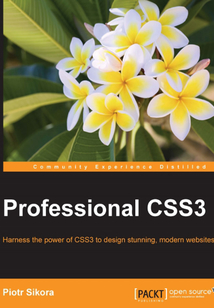目錄(104章)
倒序
- coverpage
- Professional CSS3
- Credits
- About the Author
- About the Reviewer
- www.PacktPub.com
- eBooks discount offers and more
- Preface
- What this book covers
- What you need for this book
- Who this book is for
- Conventions
- Reader feedback
- Customer support
- Chapter 1. Foundations and Tools
- Choosing the right IDE
- Cross browser compatibility – which browsers should you install?
- Preprocessor – why should you use them?
- SASS foundation
- Simple automatization (with Gulp)
- Pixelperfect layouts tools
- Checking compatibility
- Good assumptions in code
- Creating proper selectors
- Preparing your project
- Summary
- Chapter 2. Mastering of Fundamentals
- Traditional box model
- Floating elements
- Display types
- CSS elements positioning
- Summary
- Chapter 3. Mastering of Pseudoelements and Pseudoclasses
- Pseudoclasses
- Usage of pseudoclasses
- Supporting forms styling with pseudoclasses
- Drawing primitives with CSS
- Pseudoelements
- Summary
- Chapter 4. Responsive Websites – Prepare Your Code for Specific Devices
- The foundation of responsive websites
- Media queries – where can you use it
- Usage sample – main navigation
- Summary
- Chapter 5. Using Background Images in CSS
- CSS backgrounds
- Retina problems
- Summary
- Chapter 6. Styling Forms
- Forms – the most known issues
- Forms – enable superpowers
- Summary
- Chapter 7. Resolving Classic Problems
- Centering elements
- Dealing with opacity
- Summary
- Chapter 8. Usage of Flexbox Transform
- Flexbox
- More about transform
- Summary
- Chapter 9. Calc Gradients and Shadows
- The calc() method
- Gradients in CSS
- How to add box-shadow
- How to add text-shadow
- Additional font and text features
- Data attribute
- Summary
- Chapter 10. Don't Repeat Yourself – Let's Create a Simple CSS Framework
- File structure
- Short forms of useful elements
- Other mixins
- Media queries
- Grids
- Standard reusable structures
- Gathering other reusable mixins
- Let's test and use our framework
- Remember!
- Summary
- Chapter 11. Mailers Fundamentals
- Testing your mailer
- Back to tables
- Targeting specific devices through media queries
- Inlining the e-mail template
- Tips for e-mail template development
- Testing with Litmus
- Summary
- Chapter 12. Scalability and Modularity
- Building scalable and modular code
- CSS methodologies
- Which methodology should you use?
- Maybe your own methodology?
- Summary
- Chapter 13. Code Optimization
- Self-optimization
- Summary
- Chapter 14. Final Automatization and Processes Optimization
- Gulp
- Jade as your templating engine
- UnCSS
- Minifying CSS
- Final automatizer
- Summary
- Index 更新時間:2021-07-02 16:39:56
推薦閱讀
- Advanced Machine Learning with Python
- Manga Studio Ex 5 Cookbook
- 程序員面試算法寶典
- Android 9 Development Cookbook(Third Edition)
- Java:Data Science Made Easy
- Silverlight魔幻銀燈
- Python高效開發(fā)實戰(zhàn):Django、Tornado、Flask、Twisted(第3版)
- Java Web開發(fā)技術(shù)教程
- Getting Started with Python Data Analysis
- jQuery開發(fā)基礎(chǔ)教程
- Learning OpenStack Networking(Neutron)(Second Edition)
- 基于Struts、Hibernate、Spring架構(gòu)的Web應(yīng)用開發(fā)
- Learning Continuous Integration with TeamCity
- RESTful Java Web Services(Second Edition)
- 智能搜索和推薦系統(tǒng):原理、算法與應(yīng)用
- Visual C#.NET Web應(yīng)用程序設(shè)計
- 虛擬現(xiàn)實建模與編程(SketchUp+OSG開發(fā)技術(shù))
- 深入理解Zabbix監(jiān)控系統(tǒng)
- Web程序設(shè)計與架構(gòu)
- 區(qū)塊鏈原理、設(shè)計與應(yīng)用
- The Java Workshop
- 自然語言處理NLP從入門到項目實戰(zhàn):Python語言實現(xiàn)
- PHP7實踐指南:O2O網(wǎng)站與App后臺開發(fā)
- C語言程序設(shè)計
- 零基礎(chǔ)學(xué)C# 3.0
- 分布式中間件技術(shù)實戰(zhàn):Java版
- Learning OpenStack High Availability
- Mastering the C++17 STL
- 計算機組裝與維護(hù)(第二版)
- Network Backup with Bacula How-to


